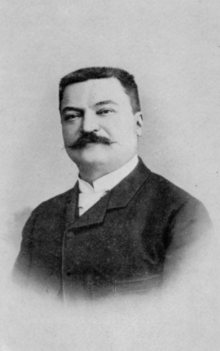Édouard Lucas
François Édouard Anatole Lucas (born April 4, 1842 in Amiens , † October 3, 1891 in Paris ) was a French mathematician .
Life
Lucas studied at the École normal supérieure , worked at the Paris Observatory , was a math teacher at the Lycée Saint-Louis in Paris and at the Lycée Charlemagne , also in Paris. He has studied number theory, studied generalized Fibonacci sequences , and written books on conversational mathematics. Lucas introduced mathematical-based games like Cheese Box and the Towers of Hanoi . The Towers of Hanoi appeared in 1883 as a toy under Lucas' pseudonym “N. Claus de Siam ”, which emerged from“ Lucas d'Amiens ”by exchanging letters ( anagram ).
With any real starting values a 1 and a 2 , a sequence of numbers is recursively defined as a special case of a Lucas sequence by
- .
This is a generalization of the Fibonacci numbers . As with the Fibonacci sequence, the quotient of two consecutive numbers converges to the golden ratio .
His prime test for Mersenne numbers was simplified by Derrick Henry Lehmer in 1930 (see Lucas-Lehmer test ) and Lucas used it to prove in 1876 that 2 127 −1 is prime. Another primality test named after him is the Lucas test , which is an inversion of Fermat's little theorem .
In 1875 Lucas set the task of showing that the only solution to the Diophantine equation
- For
N = 24 and M = 70. It wasn't until 1918 that George Neville Watson gave a proof with hyperelliptic functions. The formula appears in boson string theory (boson means that they don't describe fermions like superstrings, they only exist in 26 dimensions).
Lucas died after an extremely bizarre accident at the French Mathematical Society's banquet : dishes fell off a waiter and a broken plate injured Lucas on the cheek. He died of blood poisoning a few days later.
Works
- Application de l'arithmétique à la construction de l'armure des satins réguliers , Gustave Retaux, Paris 1867 (French; online (PDF; 286 kB) at edouardlucas.free.fr)
- Recherches sur l'analyse indéterminée et l'arithmétique de Diophante , C. Desrosiers, Moulins 1873 (French; online (PDF; 1.7 MB) at edouardlucas.free.fr)
- Recherches sur plusieurs ouvrages de Léonard de Pise , Imprimerie des sciences mathématiques et physiques, Rome 1877 (French; online on Commons)
- Théorie des fonctions numériques simplement périodiques , Paris 1877 (French; online (PDF; 1.1 MB) at edouardlucas.free.fr)
- Récréations mathématiques (4 volumes), Gauthier-Villars, Paris 1882–1894 (French; Volume 1, among other things, on labyrinths ; in the Internet archive: Volumes 1 , 1 , 2 , 2 , 3 , 3 , 3 , 3 , 4 , 4 , 4 , 2nd edition volume 1 , 1 , 2 )
- Théorie des nombres , Gauthier-Villars et fils, Paris 1891 (French; in the internet archive: volumes 1 , 1 )
- L'arithmétique amusante , Gauthier-Villars et fils, Paris 1895 (French; digitized version )
literature
- Hugh C. Williams : Édouard Lucas and Primality Testing. (Canadian Mathematical Society Monographs & Advanced Texts) Wiley, New York 1998, ISBN 978-0471148524
Web links
- John J. O'Connor, Edmund F. Robertson : Édouard Lucas. In: MacTutor History of Mathematics archive .
- Édouard Lucas. Arithméticien 1842 - 1891 - with bibliography and numerous digital copies (French and English)
- Spektrum .de: Édouard Lucas (1842–1891) September 1, 2016
swell
-
↑ Édouard Lucas: Question 1180 , Nouvelles annales de mathématiques 2 e série 14, 1875, p. 336 (French; task)
Édouard Lucas: Solutions de questions proposées dans les Nouvelles annales. Question 1180 , Nouvelles annales de mathématiques 2 e série 16, 1877, pp. 429–432 (French; incomplete solution)
Find the length of a pyramid made of cannonballs, arranged in squares one above the other, consisting of an integer number of balls that make up a Square number is. An elementary proof can be found in WS Anglin: The Queen of Mathematics: An Introduction to Number Theory , Kluwer, Dordrecht 1995, p. 165 (English). - ↑ GN Watson : The problem of the square pyramid , The Messenger of Mathematics 48, 1918, pp. 1–22 (English)
- ↑ John Baez : This Week's Finds in Mathematical Physics (Week 95) , November 26, 1996 (English)
| personal data | |
|---|---|
| SURNAME | Lucas, Édouard |
| ALTERNATIVE NAMES | Lucas, François Édouard Anatole (full name) |
| BRIEF DESCRIPTION | French mathematician |
| DATE OF BIRTH | April 4, 1842 |
| PLACE OF BIRTH | Amiens |
| DATE OF DEATH | October 3, 1891 |
| Place of death | Paris |



